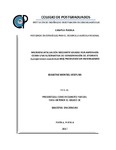Microencapsulación mediante secado por aspersión como una alternativa de conservación de jitomate (Lycopersicon esculentum Mill) producido en invernadero.
Abstract
La región de Aquixtla, en el estado de Puebla es una de las principales regiones productoras de jitomate bajo invernadero. Con frecuencia el precio del producto se ve afectado a la baja, debido al incremento de superficies de siembra y sobre todo cuando las exportaciones se detienen, teniendo como consecuencia una sobre oferta del producto a nivel nacional. Por ello, el objetivo del presente trabajo fue desarrollar una técnica que permita aprovechar en seco los excedentes de producción para extraer el licopeno, un potente antioxidante. Se siguieron tres etapas: a) Caracterizar el sistema de producción de jitomate, b) Evaluar el contenido de licopeno en deshidratados y c) Analizar el contenido de licopeno en encapsulados. Para el primer estudio se aplicó un cuestionario a 72 productores de jitomate. En el segundo estudio se evaluaron las concentraciones de licopeno de las muestras sometidas a secado convectivo y secado por aspersión con diferentes condiciones y variables de proceso, por último, en la tercera etapa se analizó la concentración de licopeno en encapsulados obtenidos con diferentes proporciones del material encapsulante. Los resultados muestran que el 88.9 % de los agricultores utiliza la fertirrigación como sistema de producción, emplean jitomate tipo saladette (90.1%) y se observa que con frecuencia el precio del producto se encuentra cercano al costo de producción ($3-4 kg). Por otra parte se presentó un efecto positivo en la concentración de licopeno con 50 y 60 % de jitomate en polvo, una temperatura de entrada de 170 °C y 9 mL min-1, finalmente el tratamiento con igual proporción de encapsulante (maltodextrina/goma arábiga) presentó mejor rendimiento y características que sugieren tener un producto estable, viable para su incorporación en diversos productos. Por todo ello, se concluye que la encapsulación resulta ser una técnica alternativa de conservación y aprovechamiento para la sobreproducción de jitomate. _______________ MICROENCAPSULATION BY SPRAY DRYING AS AN ALTERNATIVE CONSERVATION OF TOMATO (Lycopersicon esculentum Mill) GROWN IN GREENHOUSE. ABSTRACT: The region of Aquixtla, in the state of Puebla is one of the main producing regions of tomato under greenhouse. Often the price of the product is affected to low, for the increase of sowing surfaces and especially when the exports stop, having as a consequence an over supply of the product at national level. Therefore, the objective of the present work was to develop a technique that allows use in dry the overproduction to extract lycopene, a potent antioxidant. Three stages were followed: a) Characterize the tomato production system, b) Evaluate the content of lycopene in dehydrated, and c) Analyze the content of lycopene in encapsulates. For the first study, a questionnaire was applied to 72 tomato producers. In the second study the concentrations of samples subjected to convective and spray drying with different conditions and process variables were evaluated. Finally, in the third stage, the concentration of lycopene was analyzed in encapsulated obtained with different proportions of encapsulant material. The results show that 88.9% of the farmers use fertirrigation as a production system, they use tomato saladette type (90.1%) and is noted that frequently the price of the product is close to the cost of production ($ 3-4 kg). On the other hand, a positive effect was observed in the concentration of lycopene with 50 and 60% of tomato powder, an inlet temperature of 170 °C and 9 mL min-1, finally the treatment with the same ratio of encapsulant (maltodextrin/gum arabic) presented higher yield and characteristics that suggest that a stable product were obtained, viable for incorporation into different products. Therefore, it is inferred that the encapsulation can be an alternative technique of conservation and could be used with overproduction of tomato.
Collections
- Tesis MC, MT, MP y DC [398]


